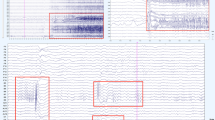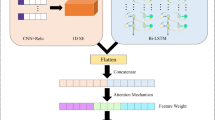Abstract
Epilepsy affect almost 1% of the worldwide population. An early diagnosis of seizure types is a crucial patient-dependent step for the treatment selection process. The selection of the proper treatment relies on the correct identification of the seizure type. As such, identifying the seizure type has the biggest immediate influence on therapy than the seizure detection, reducing the neurologist’s efforts when reading and detecting seizures in EEG recordings. Most of the existing seizure detection and classification methods are conceptualized following the patient-dependent schema thus fail to perform well with unknown cases. Our work focuses on patient-independent schema for seizure type classification and pays more attention to the explainability of the underlying attention mechanism of our method. Using a channel-wise attention mechanism, a quantification of the EEG channels contribution is enabled. Therefore, results become more interpretable and a visualization of brain lobes contribution by seizure types is allowed. We evaluate our model for seizure detection and type classification on CHB-MIT and the recently released TUH EEG Seizure, respectively. Our model is able to classify 8 seizure types with an accuracy of 98.41%, directly from raw EEG data without any preprocessing. A case study showed a high correlation between the neurological baselines and the interpretable results of our model.









Similar content being viewed by others
Explore related subjects
Discover the latest articles and news from researchers in related subjects, suggested using machine learning.Notes
The PrePrint version was published on the TechRxiv server: https://doi.org/10.36227/techrxiv.17087147.v1Baghdadi et al. (2023).
References
Abbasi MU, Rashad A, Basalamah A, Tariq M (2019) Detection of epilepsy seizures in neo-natal eeg using lstm architecture. IEEE Access 7:179074
Ahmedt-Aristizabal D, Fernando T, Denman S, Petersson L, Aburn MJ, Fookes C (2019) Neural memory networks for robust classification of seizure type. arXiv:1912.04968
Asif U, Roy S, Tang J, Harrer S (2020) Seizurenet: multi-spectral deep feature learning for seizure type classification. In: Machine learning in clinical neuroimaging and radiogenomics in neuro-oncology
Baghdadi A, Fourati R, Aribi Y, Daoud S, Dammak M, Mhiri C, Chabchoub H, Siarry P, Alimi A (2023) A channel-wise attention-based representation learning method for epileptic seizure detection and type classification. Preprint on TechRxiv,2023. https://doi.org/10.36227/techrxiv.17087147.v1
Baghdadi A, Aribi Y, Fourati R, Halouani N, Siarry P, Alimi A (2020a) Psychological stimulation for anxious states detection based on eeg-related features. J Ambient Intell Humaniz Comput 1
Baghdadi A, Fourati R, Aribi Y, Siarry P, Alimi AM (2020b) Robust feature learning method for epileptic seizures prediction based on long-term eeg signals. In: 2020 international joint conference on neural networks (IJCNN), p 1. IEEE
Bahdanau D, Cho K, Bengio Y (2015) Neural machine translation by jointly learning to align and translate. In: Bengio Y, LeCun Y (eds) 3rd international conference on learning representations, ICLR 2015, San Diego, May 7–9, 2015, Conference Track Proceedings
Chen L, Zhang H, Xiao J, Nie L, Shao J, Liu W, Chua T (2017) Sca-cnn: spatial and channel-wise attention in convolutional networks for image captioning, p 6298
Cimr D, Fujita H, Tomaskova H, Cimler R, Selamat A (2022) Automatic seizure detection by convolutional neural networks with computational complexity analysis. Comput Methods Progr Biomed. https://doi.org/10.1016/j.cmpb.2022.107277
Cisotto G, Zanga A, Chlebus J, Zoppis I, Manzoni S, Markowska-Kaczmar U (2020) Comparison of attention-based deep learning models for eeg classification. arXiv:2012.01074
Craik A, He Y, Contreras-Vidal JL (2019) Deep learning for electroencephalogram (eeg) classification tasks: a review. J Neural Eng 16(3):031001
Eom H, Lee D, Han S, Hariyani YS, Lim Y, Sohn I, Park K, Park C (2020) End-to-end deep learning architecture for continuous blood pressure estimation using attention mechanism. Sensors 20(8):2338
Fourati R, Ammar B, Aouiti C, Sanchez-Medina J, Alimi AM (2017) Optimized echo state network with intrinsic plasticity for eeg-based emotion recognition. In: International conference on neural information processing, p 718. Springer
Fourati R, Ammar B, Jin Y, Alimi AM (2020a) Eeg feature learning with intrinsic plasticity based deep echo state network. In: 2020 international joint conference on neural networks (IJCNN), p 1. IEEE
Fourati R, Ammar B, Sanchez-Medina J, Alimi AM (2020b) Unsupervised learning in reservoir computing for eeg-based emotion recognition. IEEE Trans Affect Comput. https://doi.org/10.1109/TAFFC.2020.2982143
Gao X, Zhu Y, Yang Y, Zhang F, Zhou F, Tian X, Xu K, Chen Y (2022) A seizure detection method based on hypergraph features and machine learning. Biomed Signal Process Control 77:103769. https://doi.org/10.1016/j.bspc.2022.103769
Goldenberg MM (2010) Overview of drugs used for epilepsy and seizures: etiology, diagnosis, and treatment. Pharm Ther 35(7):392
Harati A, Lopez S, Obeid I, Picone J, Jacobson M, Tobochnik S (2014) The tuh eeg corpus: a big data resource for automated eeg interpretation. In: 2014 IEEE signal processing in medicine and biology symposium (SPMB), p 1. IEEE
Hochreiter S, Schmidhuber J (1997) Long short-term memory. Neural Comput 9(8):1735
Hu H, Li Q, Zhao Y, Zhang Y (2020) Parallel deep learning algorithms with hybrid attention mechanism for image segmentation of lung tumors. IEEE Trans Ind Inf 17(4):2880
Jiang L, He J, Pan H, Wu D, Jiang T, Liu J (2023) Seizure detection algorithm based on improved functional brain network structure feature extraction. Biomed Signal Process Control 79:104053. https://doi.org/10.1016/j.bspc.2022.104053
Kaushik P, Gupta A, Roy PP, Dogra DP (2018) Eeg-based age and gender prediction using deep blstm-lstm network model. IEEE Sens J 19(7):2634
Lerche H, Shah M, Beck H, Noebels J, Johnston D, Vincent A (2013) Ion channels in genetic and acquired forms of epilepsy. J Physiol 591(4):753
Leske S, Dalal SS (2019) Reducing power line noise in eeg and meg data via spectrum interpolation. Neuroimage 189:763
Li Y, Zheng W, Wang L, Zong Y, Cui Z (2019) From regional to global brain: a novel hierarchical spatial-temporal neural network model for eeg emotion recognition. IEEE Trans Affect Comput. https://doi.org/10.1109/TAFFC.2019.2922912
Liu T, Truong ND, Nikpour A, Zhou L, Kavehei O (2020) Epileptic seizure classification with symmetric and hybrid bilinear models. IEEE J Biomed Health Inform 24(10):2844
Miao Y, Gowayyed M, Metze F (2015) Eesen: end-to-end speech recognition using deep rnn models and wfst-based decoding. In: 2015 IEEE workshop on automatic speech recognition and understanding (ASRU), p 167. IEEE
Nahmias DO, Civillico EF, Kontson KL (2020) Deep learning and feature based medication classifications from eeg in a large clinical data set. Sci Rep 10(1):1
Panayiotopoulos C (2005a) Clinical aspects of the diagnosis of epileptic seizures and epileptic syndromes. In: The epilepsies: seizures, syndromes and management. Bladon Medical Publishing
Panayiotopoulos C (2005b) Optimal use of the eeg in the diagnosis and management of epilepsies. In: The epilepsies: seizures, syndromes and management. Bladon Medical Publishing
Roy S, Asif U, Tang J, Harrer S (2019) Machine learning for seizure type classification: setting the benchmark. arXiv:1902.01012
Saputro IRD, Maryati ND, Solihati SR, Wijayanto I, Hadiyoso S, Patmasari R (2019) Seizure type classification on eeg signal using support vector machine. J Phys Conf Ser 1201:012065
Shah V, Von Weltin E, Lopez S, McHugh JR, Veloso L, Golmohammadi M, Obeid I, Picone J (2018) The temple university hospital seizure detection corpus. Front Neuroinform 12:83
Shen M, Wen P, Song B, Li Y (2022) An eeg based real-time epilepsy seizure detection approach using discrete wavelet transform and machine learning methods. Biomed Signal Process Control 77:103820. https://doi.org/10.1016/j.bspc.2022.103820
Shoeb AH (2009) Application of machine learning to epileptic seizure onset detection and treatment. PhD thesis, Massachusetts Institute of Technology
Sriraam N, Temel Y, Rao SV, Kubben PL (2019) A convolutional neural network based framework for classification of seizure types. In: 2019 41st annual international conference of the IEEE engineering in medicine and biology society (EMBC), p 2547. IEEE
Tang F-G, Liu Y, Li Y, Peng Z-W (2020) A unified multi-level spectral-temporal feature learning framework for patient-specific seizure onset detection in eeg signals. Knowl Based Syst 205:106152
Temko A, Lightbody G, Thomas EM, Boylan GB, Marnane W (2011) Instantaneous measure of eeg channel importance for improved patient-adaptive neonatal seizure detection. IEEE Trans Biomed Eng 59(3):717
Tsiouris KM, Pezoulas VC, Zervakis M, Konitsiotis S, Koutsouris DD, Fotiadis DI (2018) A long short-term memory deep learning network for the prediction of epileptic seizures using eeg signals. Comput Biol Med 99:24
Yao X, Li X, Ye Q, Huang Y, Cheng Q, Zhang G-Q (2021) A robust deep learning approach for automatic classification of seizures against non-seizures. Biomed Signal Process Control 64:102215
Yin W, Kann K, Yu M, Schütze H (2017) Comparative study of cnn and rnn for natural language processing. arXiv:1702.01923
Yuan Y, Jia K (2019) Fusionatt: deep fusional attention networks for multi-channel biomedical signals. Sensors 19(11):2429
Yuan Y, Xun G, Jia K, Zhang A (2018a) A multi-view deep learning framework for eeg seizure detection. IEEE J Biomed Health Inform 23(1):83
Yuan Y, Xun G, Ma F, Suo Q, Xue H, Jia K, Zhang A (2018b) A novel channel-aware attention framework for multi-channel eeg seizure detection via multi-view deep learning. In: 2018 IEEE EMBS international conference on biomedical & health informatics (BHI), p 206. IEEE
Zhang X, Yao L, Dong M, Liu Z, Zhang Y, Li Y (2020) Adversarial representation learning for robust patient-independent epileptic seizure detection. IEEE J Biomed Health Inform 24(10):2852–9
Acknowledgements
The research leading to these results has received funding from the Ministry of Higher Education and Scientific Research of Tunisia under the Grant Agreement Number LR11ES48.
Author information
Authors and Affiliations
Corresponding authors
Additional information
Publisher's Note
Springer Nature remains neutral with regard to jurisdictional claims in published maps and institutional affiliations.
Rights and permissions
Springer Nature or its licensor (e.g. a society or other partner) holds exclusive rights to this article under a publishing agreement with the author(s) or other rightsholder(s); author self-archiving of the accepted manuscript version of this article is solely governed by the terms of such publishing agreement and applicable law.
About this article
Cite this article
Baghdadi, A., Fourati, R., Aribi, Y. et al. A channel-wise attention-based representation learning method for epileptic seizure detection and type classification. J Ambient Intell Human Comput 14, 9403–9418 (2023). https://doi.org/10.1007/s12652-023-04609-6
Received:
Accepted:
Published:
Issue Date:
DOI: https://doi.org/10.1007/s12652-023-04609-6




